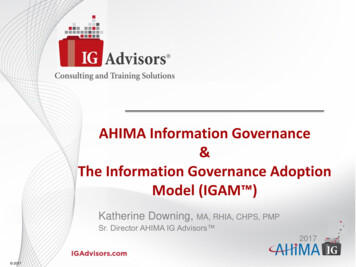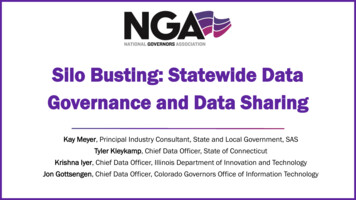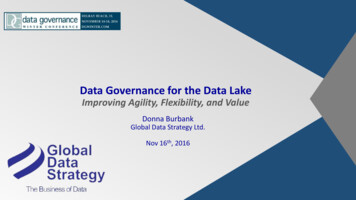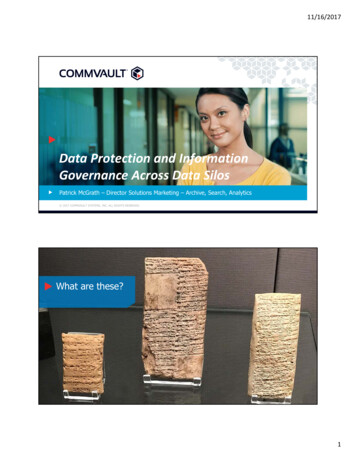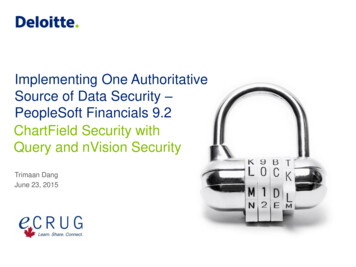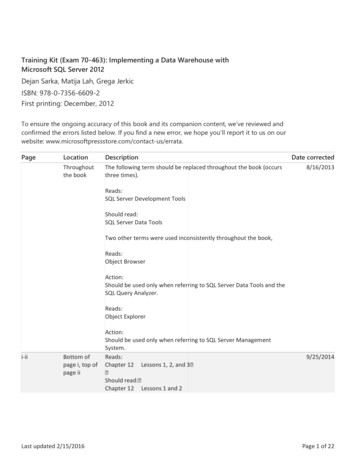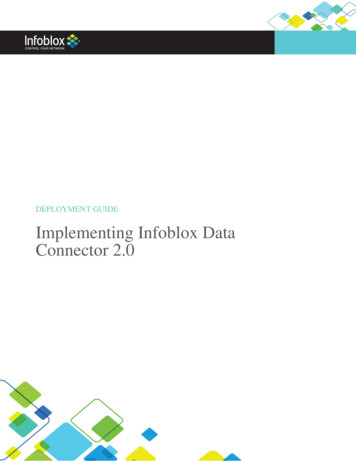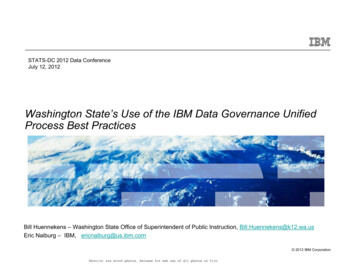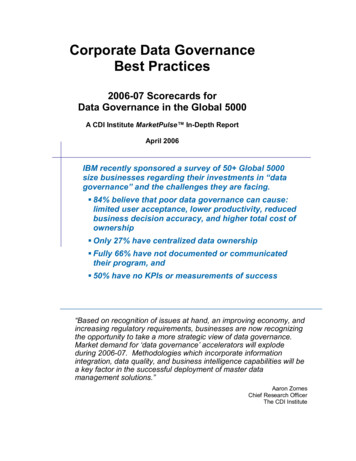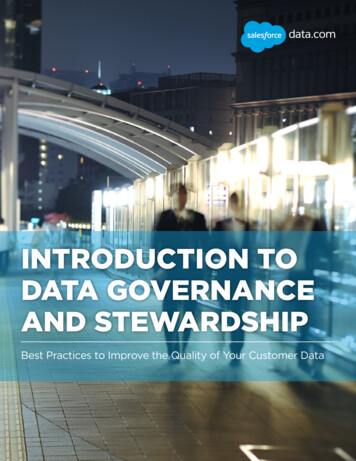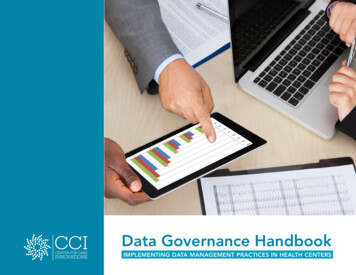
Transcription
Data Governance HandbookIMPLEMENTING DATA MANAGEMENT PRACTICES IN HEALTH CENTERS
ContentsDATA GOVERNANCE HANDBOOK TEAMWhy Does Data Governance Matter?. . . . . . . . . . 1SA Kushinka, MBA, CCI Program DirectorUsing the Data Governance HandbookJerry Lassa, MS, Principal Data Matt3rsAmy Jean Ham, PCMH CCECherbon VanEtten, MBI, Independent ConsultantDana Herrick, Dana Kay DesignFUNDED BYCalifornia Health Care Foundation as part of theSafety Net Analytics ProgramLaying the Foundation . . . . . . . . . . . . . . .3Purpose and GoalsLeadership Support and Executive SponsorshipData StrategyTools for Laying the FoundationAssembling the Team. . . . . . . . . . . . . . . . 7Data Governance CommitteeData StewardsData ServicesTools for Assembling the TeamPutting Governance in Motion . . . . . . . . . . .Training and CommunicationPolicies and ProceduresCenter for Care Innovations (CCI)1438 Webster St., Suite 101Oakland, CA ools for Putting Governance in Motion17
Why Does Data Governance Matter?Many years ago – even before electronic health records permeated the exam rooms of health centers – we firstheard the saying “you can’t make good decisions with bad data.” Unfortunately, good data seems to be hardto come by even as our information systems grow more sophisticated every day. Moore’s Law for data tells usthat the data available to us doubles every 18 months. Without a way to manage it all, we’ll drown in it.1And that’s what data governance is all about: managing data. Like the techniques, policies, and proceduresused to leverage any other valuable asset of your health center – such as people, capital, or facilities –right-sized data governance helps you to provide accurate, timely, trusted and complete information toexecutives and front line staff alike. Taking that idea further, Health Catalyst describes the “Triple Aim ofData Governance” that nicely sums up what data governance should do:MAXIMIZEDATA USEDATAGOVERNANCEIMPROVEDATAQUALITYSCENARIO 1. A team of “super users” at a healthcenter was responsible for building EHR templatesand setting system parameters. When one of thecare teams asked the EHR team to create more userfriendly names for the cancer screening labs, theyreadily complied. Unfortunately, the EHR team wasunaware of the need to map results coming in froman external laboratory to the lab results field in theEHR by using the same LOINC codes. The healthcenter began seeing a dramatic decrease in cervicalcancer screening rates. When investigating, thedata analyst found all labs being pulled onto thereports, but had no idea that results had stoppedinterfacing to the EHR. Better education of the EHRteam and stricter controls on critical system changes– both a function of data governance – would haveprevented this.SCENARIO 2. A clinic manager added a new visitINCREASEDATALITERACYIn the video segment Data Governance for High Functioning Health Centers, Dale Sanders notes that datagovernance is nothing new; other industries have embraced these ideas and procedures long ago. It’s new inhealth care because we’re just becoming digital and are now producing electronic data – lots and lots of data!Add to that the rapid growth and uncertain operating environment health centers find themselves in and it’seasy to understand how overwhelming data governance can seem. Like most vexing challenges, the flip sideof the coin is the opportunity to provide high value at relatively low cost or effort. See if you can recognize yourhealth center in the scenarios presented in the sidebar.type to the appointment scheduling system to helpproviders understand the reason for the patients’visit. Within a month, visit volume reports started toshow a dramatic decline in productivity. The DataServices team was asked to investigate the cause.It was found that the productivity reports wereprogrammed to run off a list of visit-types from amaster file. The new visit type had not been addedto this file. Good data governance procedures andcommunication would have prevented this situationby ensuring that the interconnectedness of dataelements and the consequences of making changesare understood by all.1. Point B issue brief How to Turn Your Data Governance Project into a Long-Term Success, 2015DATA GOVERNANCE HANDBOOK1
Using the Data Governance HandbookWhether you identify with one or many of the stories shared throughout, this handbook will help you beginto treat your data as organizational currency. The Data Governance Handbook and its companion, Buildinga Data Driven Culture (datadrivenculture.org) video learning series provide practical tools and guidance forimplementing effective data governance.Outlined are critical building blocks for an effective data governance program that are organized into threephases:Data governance is a journey.Start small, produce value andgrow the data governance Laying the Foundation. Focuses on identifying the problems you are trying to solve, what you would liketo achieve, and establishing leadership support. Assembling the Team. In addition to leadership support, you will need to gather together otherstakeholders and resources. Putting Governance in Motion. Having completed the work of the first two phases, you will be ready toexecute your data governance plan. This phase provides guidance on training and communication,as well as policy and procedure development.function as your organizationIn addition to the building blocks and tools, we’ve also directed you to specific videos in the learning centerthat give more context and depth to the topics covered. Look for these featured sidebars throughout thehandbook.and information needs grow. TEMPLATES, EXAMPLES AND RESOURCES KNOWLEDGE CENTER VIDEOSAs you review the data governance building blocks, don’t be surprised to learn that you already have somepieces of data governance in place. Use this handbook to acknowledge and celebrate what you are alreadydoing and identify the work that remains. The tools, templates, and principles described in each buildingblock will help you put the right amount of structure and process in place without becoming burdensometo producers or consumers of data. The tools and samples are meant to help communicate roles, establishaccountability, highlight interdependence, and promote efficiency. Remember, data governance is a journey.Start small, produce value and grow the data governance function as your organization and informationneeds grow. Above all, let us know what works for you and what tools you have to share so this handbook canrobustly support all health centers.2 CENTER FOR CARE INNOVATIONS
Laying the FoundationLeaders need to model data-drivenPurpose and Goalsand without guidance from leaders aboutData governance is like any other project or process, it needs to have a purpose – a reason to exist; in otherwords, a problem to solve. The problems that need to be addressed by data governance are often surfacedby those closest to the problems, such as a Data Analyst or Quality Improvement Manager or an end userof the data, and a typical starting place is a desire to solve data quality problems. Other times, the need fordata governance evolves from an existing committee or project, such as an EHR implementation team or anexecutive team meeting where organizational priorities are set. Regardless of how the need for governancesurfaces, the purpose should always include a clear value proposition and keep in mind the “Triple Aim ofData Governance:” improving data quality, increasing data literacy and maximizing the use of data. This willkeep the effort focused on value and not governance for governance sake. Successful governance startssmall – don’t try to fix the data in all departments and systems at once. To get started, define how governancesupports the organization’s mission with a compelling initial purpose and SMART (Specific, Measurable,Attainable, Results-oriented, Time-bound) goals.be focusing efforts on the wrong areas. AtLeadership Support and Executive SponsorshipWhile data analysts can provide data andStrong leadership support and engaged executive sponsors are critical success factors for governance evenif the need for governance often arises from other levels in the organization. Leaders are in a unique positionto communicate the degree to which the organization views analytics as a strategic imperative and supportsa structured approach to managing data resources. They serve as role models for how to take a data-drivenapproach to decision making, support the adoption of data governance processes, and influence datapriorities to meet organizational goals. Leaders establish or endorse the Data Governance Committee thattypically includes an executive sponsor, other departmental leaders, data stewards and data analysts. Withoutleadership support and leaders who model data driven behavior, governance efforts are likely to stall.Data StrategyA data strategy is a documented plan that defines resource allocation, activities, and timeframes for addressingdata acquisition, completeness, accuracy, timeliness and use. Documenting key components of your datastrategy – which include things like data sources, data quality, data “ownership”, data privacy and security, datatimeliness, level of detail needed, type of analyses needed, data storage and retention – can ensure that datadeficiencies are remedied and that the organization has the right information to achieve its goals. The planshould be widely understood and considered a “living” document that responds to organizational priorities.behavior. The Data Services team is almostalways inundated with information requestsorganizational priorities, the data team couldone health center, a data analyst was taskedwith ensuring providers’ eligibility for theMeaningful Use (MU) program. In additionto conducting training on the MU measures,he created a monthly spreadsheet to show ifproviders were in danger of missing the MUthreshold. As providers were missing the goal,he continued to reach out to the CMO. Atthe end of the year, several providers didn’tmeet the eligibility goals, including the CMO.recommendations, it takes the organization’sleaders to act upon that data for improvementand model data-driven behavior.DATA STRATEGY TIPSTo keep things manageable, try developing adata strategy for an organizational priority thathas the attention of your senior leaders and has“boundaries.” This could include: A key quality initiative A priority objective from yourorganization’s strategic plan A pay-for-performance program An important grantDATA GOVERNANCE HANDBOOK3
Tools for Laying the FoundationTips for Getting StartedKeep these tips in mind as you start to put data governance practices into place:TEMPLATESFOR LAYING THE FOUNDATION DataStrategy Worksheet Analytics Capability Assessment Choose a specific measure set to start with and build trust in the data by examining the data input and output. Startingsmall and keeping your efforts within one department will help to keep your work manageable, allow you to fine tuneprocesses, and help your team to show value right away. Make sure you have an executive sponsor, champion or leadership support from a clinical or operational area. A big mistakehealth centers make is to assume that data governance and management is the responsibility of IT. Use the opportunity to get one or two end users really excited about data they can trust; these staff can become datastewards in the future. Although you’re starting small and focused, avoid referring to data governance or management as a “project”. Instead, lineup your next data management effort early on so that everyone knows the work will continue. Build policies and procedures as needed. Present these as communication tools rather than rules. Some staff may mistakegovernance for restricted access; in fact, it’s just the opposite.Analytics Capability AssessmentAnalyticsInstructions: CapabilityEvaluate each questionAssessmentin the first column of the assessment matrix and select a score that reflects your organization’s capability by circling acorresponding number. Total your score in each of the three domains then divide by the number of factors in each one (People 4, Process 6, Technology 3) todetermine youryouraveragescore for thatcapabilitiesdomain. To assess yourorganization’scapabilityoverall, total forthe scoresof each domainanalytics,and divide by 3.GeneralTo reconsiderusing thecharacteristics of each level are described below.AnalyticsCapabilityAssessment(ACA) and administeringit on an annualspecifically forCapabilityLevelsReactiveResponsiveProactive basis. DevelopedPredictiveNo evidenceor very limitedSomeenvironmentdepartmental evidence andEvidenceof an emergingFully integratedand alignedGeneralCharacteristicshealthcentersand ssmentcan helpevidence of capability,but not integrated or aligned,integrated approach, clinical and organizationally, leading edgedecentralized efforts to getinitial data marts, standardizedbusiness process improvements tools and skills, data servicesfocus capacity building effortsand influencethe work of the datagovernance committee,especially as itdata, access to information forreporting through IT, improvedbased on analytics, analyticsprovide robust support acrossfirst time, situationaldata capture at departmentdriving change and strategy,the health center, automatedrelates to building data el, some historical trendingculture change, integration ofanalytic results are fed back intoand analysis.measure across domainsAnalytics(clinical, financial,operations,patient experience).predictive models for value-CapabilityAssessmentdriven health care.Factor ExampleA S S E S S M E N T(See sidebar to download complete temp
Use this handbook to acknowledge and celebrate what you are already doing and identify the work that remains. The tools, templates, and principles described in each building block will help you put the right amount of structure and process in place without becoming burdensome to producers or consumers of data. The tools and samples are meant to help communicate roles, establish accountability .
